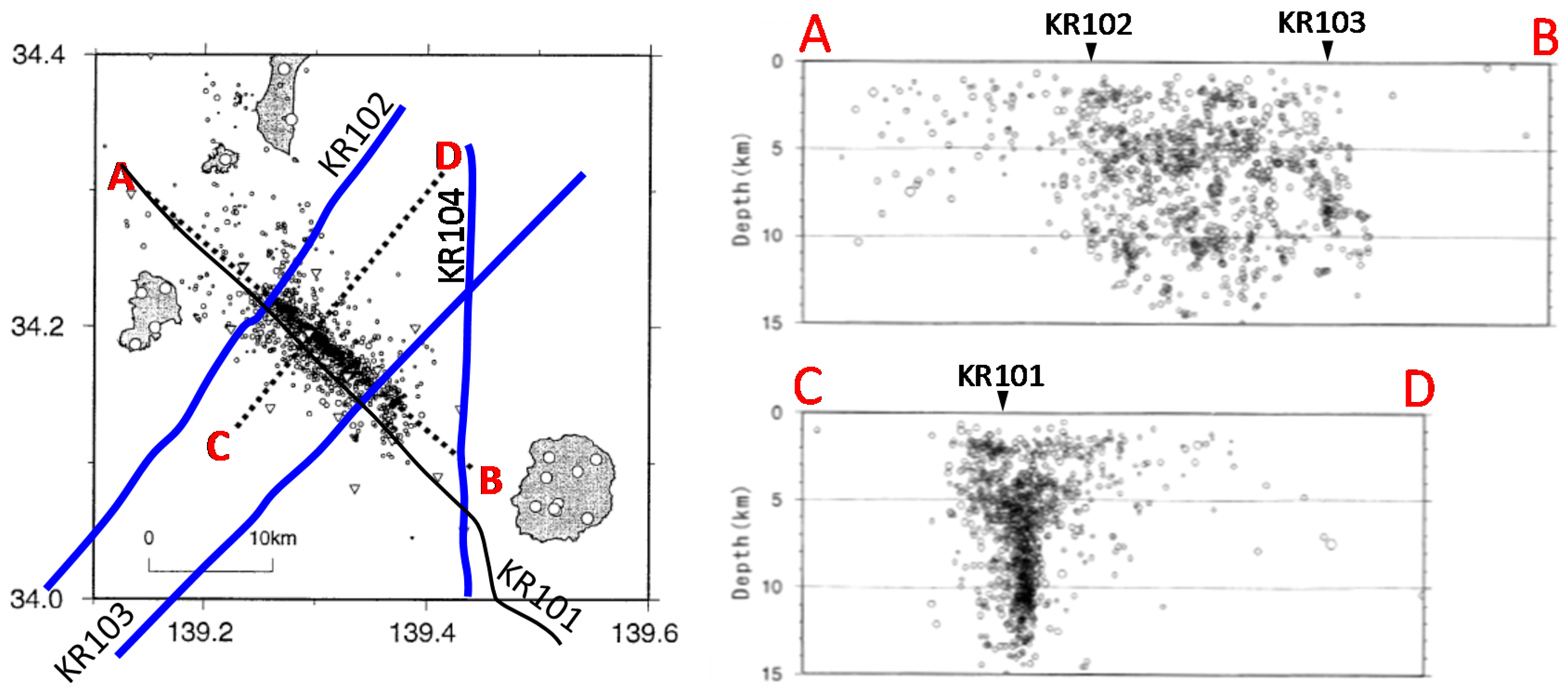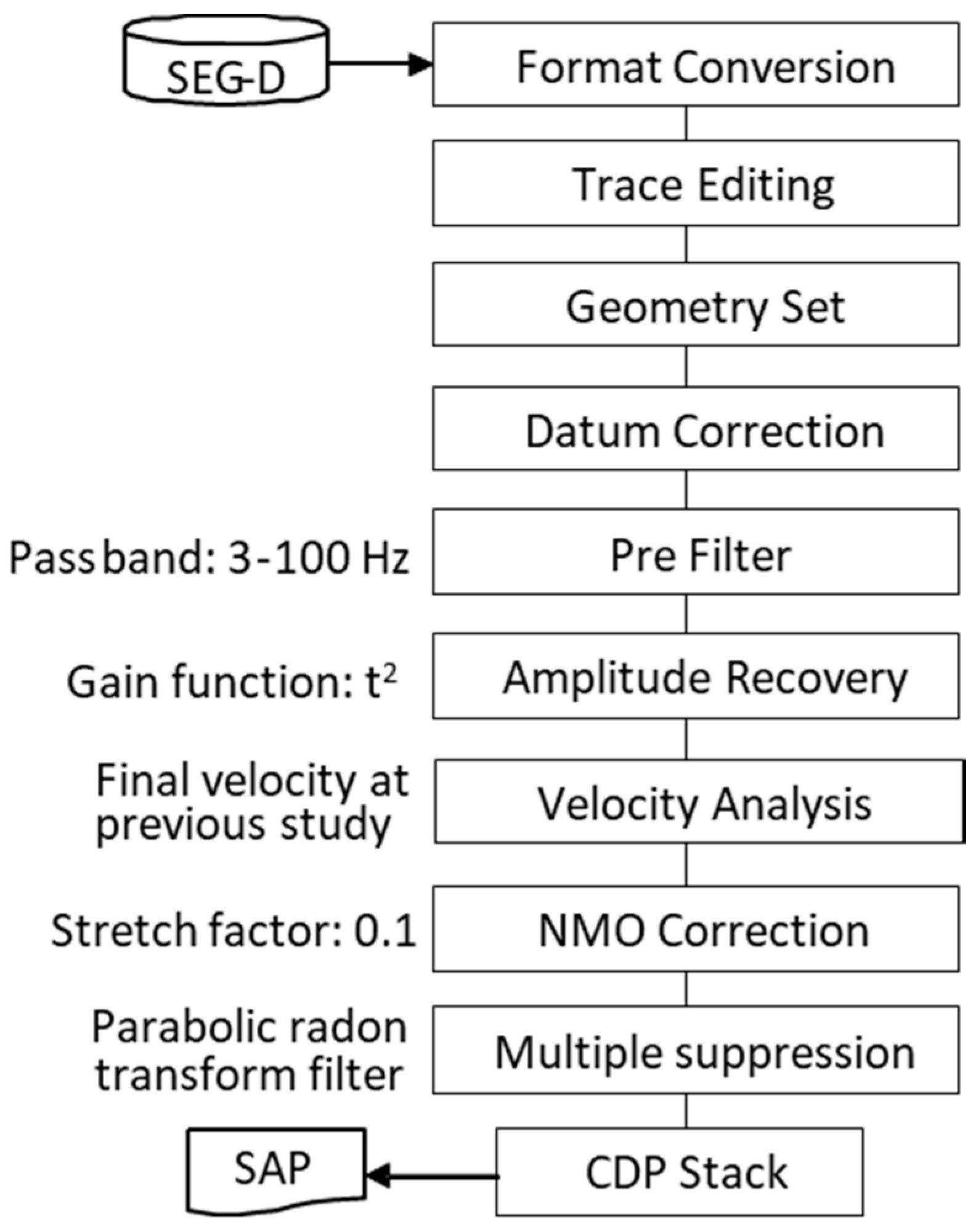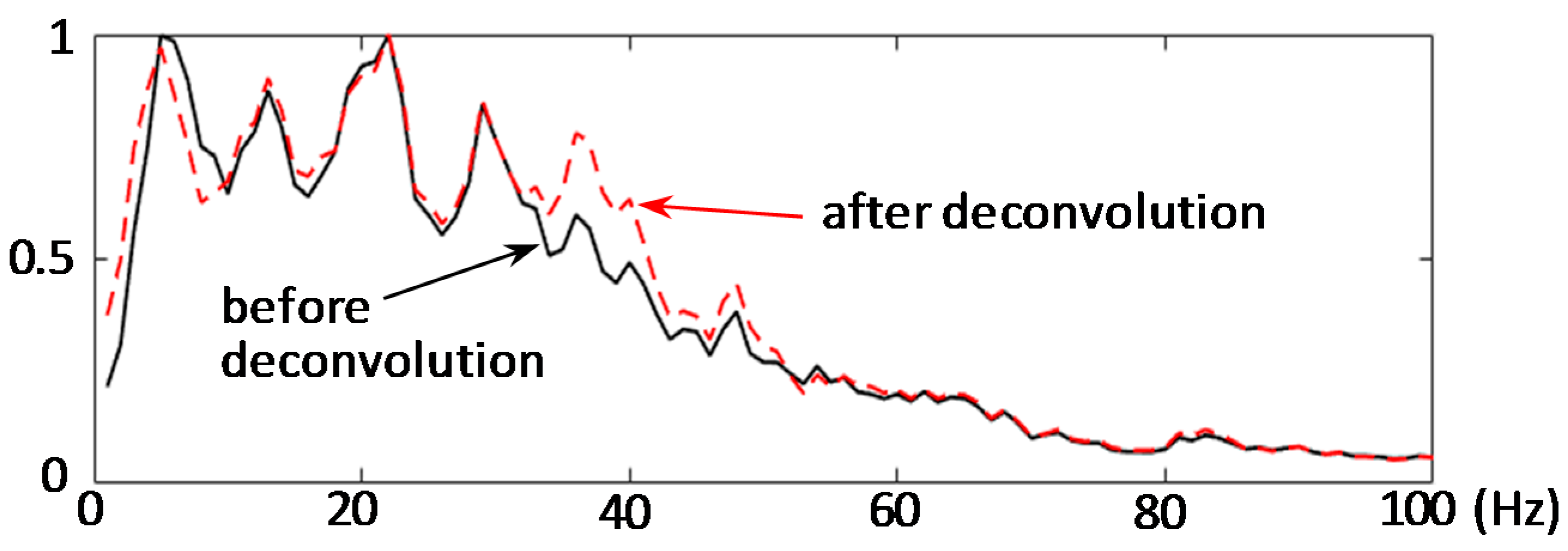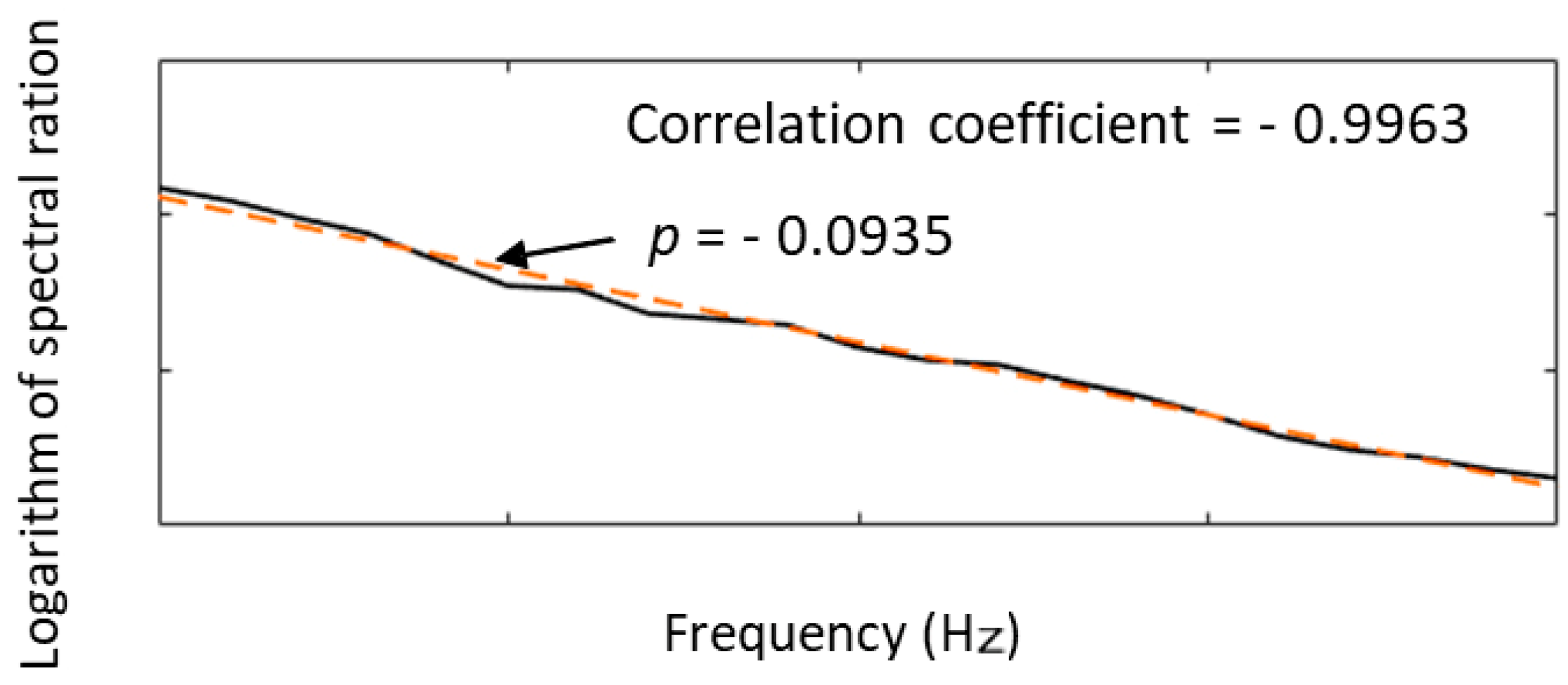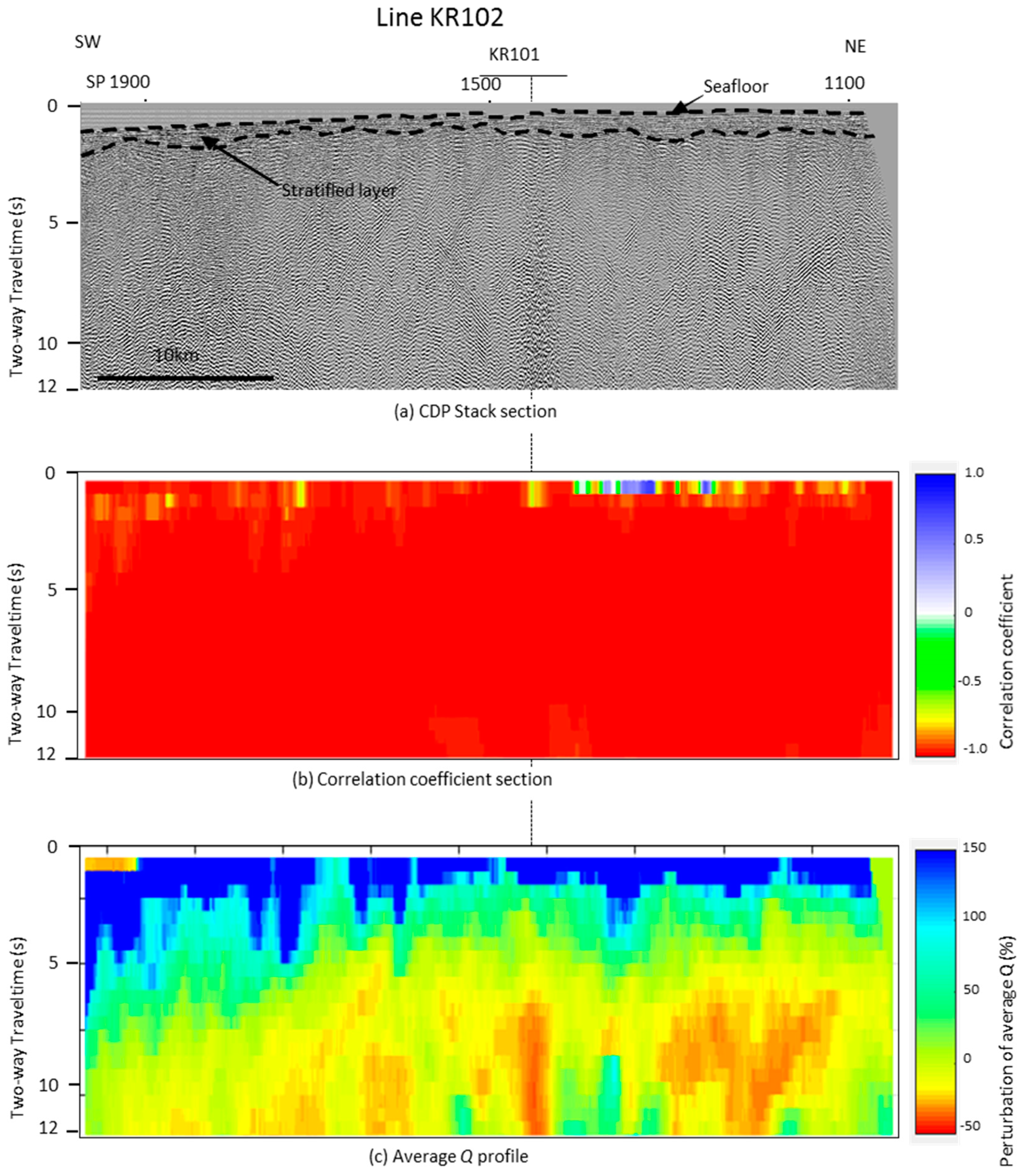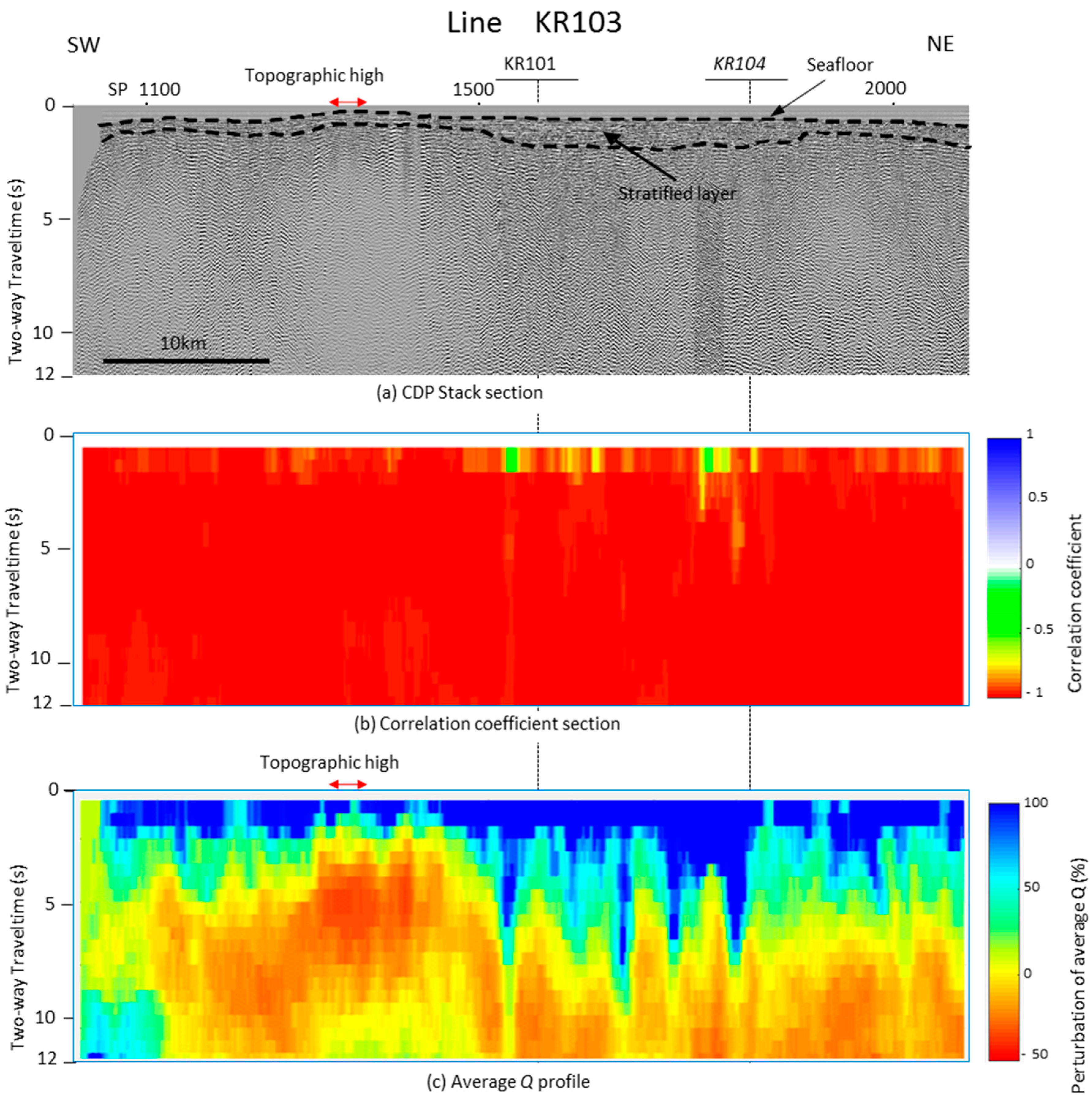1. Introduction
Seismic reflection profiles are widely used in oil and gas exploration, and studies of crustal structure, because they enable researchers to visualize sedimentary structures on the basis of reflection continuity and faults on the basis of offset reflections. However, the reflection profiles are unable to be utilized in poorly reflective areas, such as volcanic areas or highly fractured regions, where seismic reflections are inherently difficult to observe.
Only a few techniques have been tested to overcome this limitation, most notably seismic attribute analysis [
1] and seismic scattering analysis [
2]. These methods focus on seismic attributes other than reflection amplitude to successfully extract subsurface geological information. From the same point of view, we applied seismic attribute analysis based on the attenuation property called ‘seismic attenuation profiling’ (SAP) in a previous study [
3]. This study looked at the volcanic area between the Miyakejima, Kozushima, and Niijima island volcanos in Japan (
Figure 1). It discerned a remarkable, down-warping, high-attenuation anomaly on a seismic survey line (KR101) between Miyakejima and Kozushima islands, which was well-correlated with the hypocenter distribution of the earthquake swarm associated with the 2000 eruption of Miyakejima Volcano (
Figure 2). However, no significant geological features have been observed on the other seismic lines (KR102, KR103, and KR104). Specifically, the signal-to-noise (S/N) ratio and the frequency distortion of seismic reflection data to be input to SAP analysis remains an obstacle in expanding SAP method to a regional study and to spatial or 3D applications. To address this problem, this study is a re-examination of the preprocessing of the seismic reflection data that were used in the previous SAP study [
3].
2. Methods
The SAP method is a technique for imaging seismic attenuation structures from seismic reflection data [
3]. The method can be used for geophysical imaging in poorly reflective areas such as volcanic or highly-faulted regions, because it does not require continuous reflections. However, the current SAP method, which uses the spectral ratio, has a disadvantage in that it is dependent on the quality of the input seismic reflection data. It is particularly reliant on effective frequency preservation during data preprocessing, such as normal moveout (NMO) correction and deconvolution.
Previously, we used poststack seismic data because of high S/N ratio [
3], whereas prestack data was used in another previous study [
6] to avoid frequency distortion by NMO correction. However, neither study addressed deconvolution effect in frequency content preservation; thus, we excluded deconvolution from the preprocessing sequence in the present study. Thereafter, to reduce the effects of frequency distortion caused by NMO correction, a very small NMO stretching factor of 0.1 (10%) was adopted. The preprocessing flow chart used in this study is shown in
Figure 3.
Figure 4 shows an example of frequency distortion by deconvolution. Spectrums before and after the deconvolution are compared in this figure. As seen in the figure, the relatively high frequency components of 30–50 Hz are raised by the deconvolution. Therefore, it is better to exclude the deconvolution from the preprocessing sequence.
Figure 5 is an example of frequency distortion by NMO stretch factor. The top figure shows difference in spectrums by NMO stretch factors: 0.5, 0.1, and 0.05. Both frequency contents from the stretch factors 0.1 and 0.05 are nearly consistent. However, the frequency content from the stretch factor 0.5 is significantly different from the others. Those results indicate that we should use the stretch factor of 0.1 for the seismic reflection data presently used. The bottom figure shows CDP gathers after NMO correction with every stretch factor. We can also see that both CDP gathers by the NMO correction with stretch factors 0.1 and 0.05 are nearly consistent.
For this study, we assumed that
Q is constant over the seismic frequency band, as many previous authors did [
7], although
Q is frequency-dependent [
8]. We calculated the average
Q value by using the spectral ratio method, which is a general method for
Q estimation [
9,
10]. The temporal decay in the amplitude of a propagating seismic wave of frequency
f from traveltime
t1 to traveltime
t2 is written as a function of
Q:
in which
δt =
t2 −
t1;
At1 and
At2 are the amplitude spectra of the wavelet at
t1 and
t2, respectively; and
G and
R are the geometrical spreading and reflection coefficients, respectively. Taking the spectral ratio and then the logarithms of both sides yield:
Given that the logarithm of the spectral ratio is a linear function of frequency f, as expressed in Equation (2), Q can be computed from its gradient p by using Equation (3) for the time window between t1 and t2.
As shown in
Figure 6, we computed the gradient
p by linear approximation with the least squares method. To evaluate the reliability of the
Q estimation by the spectral ratio method, the correlation coefficients of the linear approximation were calculated at every location.
4. Discussion
Several new attenuation anomalies were identified from the seismic attenuation profiles. They all were not imaged in the previous study [
3]. Regarding the vertical high-attenuation anomaly observed on KR102 (
Figure 7c), its shape is very similar to that of the cross section of the 2000 earthquake swarm shown in
Figure 2. Additionally, its location is consistent with that of the swarm. Considering these similarityies in shape and location, it can be concluded that the vertical high-attenuation anomaly reflects the cross section of the hypocenter distribution of the 2000 swarm.
An up-warping high-attenuation anomaly was newly imaged beneath the topographic high on KR103 (
Figure 8c). Based on the geological feature of the study area, which is located on the northern part of the Izu Islands and consists of a chain of volcanic islands [
11], it can be considered that this topographic high was formed by the same volcanism as the volcanic islands. Therefore, this up-warping, high-attenuation anomaly on KR103 may reflect one of the volcanic activities that have repeatedly occurred in this region. Another up-warping high-attenuation anomaly was observed on KR104 in the present study (
Figure 9c). The location of the anomaly is relatively near the Miyakejima volcano (
Figure 1). Although it is difficult to specify spatial variation in geologic structure by sparse 2D seismic grid, this high-attenuation anomaly on KR104 may reflect the same volcanism mentioned above, because of the similarity in location.
Here, we further consider what geological feature(s) the high-attenuation anomalies reflect. According to previous studies, high-attenuation property reflects volcanism [
2], fault activity [
14], and gas reservoir [
6]. Regarding the gas reservoir, there are no gas fields in the study area; therefore, it cannot be considered as a candidate for the high-attenuation anomalies observed in the present study. Fault activity associated with earthquake swarm becomes a possible candidate. However, no precise hypocenter distributions of earthquake swarms have been measured in the study area before the 2000 earthquake swarm occurred. Because only the hypocenter distribution of the 2000 swarm is available, the justification of the high-attenuation anomalies by fault activity is limited to only a few locations along the seismic lines.
On the other hand, volcanism is the most dominant geological feature in the study area [
11], being applicable to every location in the study area. Concerning the vertical high-attenuation anomaly on KR102, its shape is very similar to that of the dike inclusion of magma associated with the 2000 Miyakejima eruption, which was deduced by the previous studies [
5]. Regarding the up-warping, high-attenuation anomalies on KR103 and KR104, it is presently difficult to explain their causes by faults because their locations do not relate to the hypocenter distribution of the 2000 swarm. However, the anomaly on KR103 is located on the topographic high, suggesting volcanic activity and the anomaly on KR104 near the Miyakejima volcano. Thus, volcanism, which has been repeatedly occurred in this region, is likely the candidate cause of the high-attenuation anomalies newly observed in the present study.
As mentioned above, our observations suggest a relationship between the high-attenuation anomalies and volcanic activity along KR103 and KR104. This relationship suggests the presence of porous lithology that is often the result of volcanism.
5. Conclusions
Data preprocessing was revaluated to improve frequency preservation when handling input seismic data for SAP analysis. Deconvolution was excluded from the processing sequence, and NMO correction was applied with a very small stretching factor of 0.1. The resulting attenuation profiles successfully imaged the following high-attenuation anomalies that were not identified in the previous studies.
A vertical high-attenuation anomaly on KR102 that probably reflected a cross section of the hypocenter distribution of the 2000 earthquake swarm.
High-attenuation anomalies on KR103 and KR104 that likely reflected the volcanic activities that have repeatedly occurred in this region.
Although further investigation is still needed, this study demonstrated that our altered preprocessing improved the accuracy of geological structural imaging by SAP.

